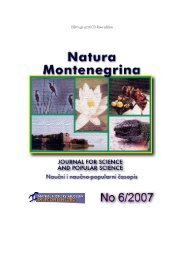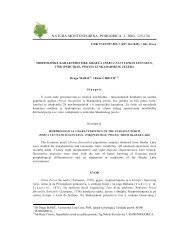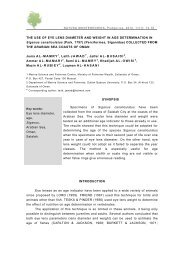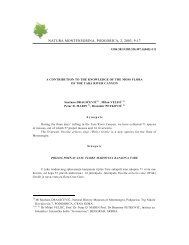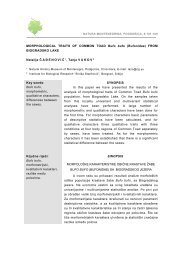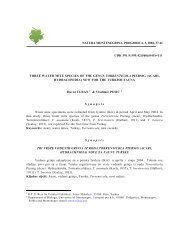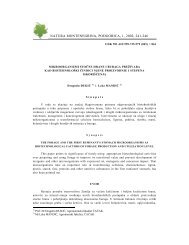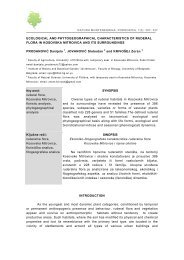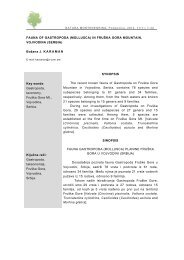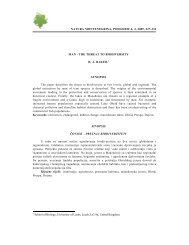Djurkovic_et_al_NM4.pdf
Djurkovic_et_al_NM4.pdf
Djurkovic_et_al_NM4.pdf
You also want an ePaper? Increase the reach of your titles
YUMPU automatically turns print PDFs into web optimized ePapers that Google loves.
196<br />
Natura Montenegrina, 4/2005<br />
INTRODUCTION<br />
The reservoir was formed by the V<strong>et</strong>ernica River, 30 km upstream of the town of<br />
Leskovac at the place c<strong>al</strong>led Barje. The first, primary aim was to protect Leskovac from<br />
flooding waters, afterwards as the protection from sediments compiling, for regulation of flow<br />
and ensurance of guaranteed biologic<strong>al</strong> minimum. Today this reservoir is primarily used for<br />
water supply for town of Leskovac and the municip<strong>al</strong>ity of Lebane. Concerning the fact that<br />
the filling was ended in 1995, that year has been taken as a zero point for water qu<strong>al</strong>ity<br />
d<strong>et</strong>ermination. At maximum the reservoir has the volume of 40.6 · 10 6 m 3 , whilst the area is<br />
139 hectares. In the conditions of norm<strong>al</strong> USPOR the volume is 26.2 · 10 6 m 3 with maxim<strong>al</strong><br />
depth of 25 m. The average width is 300 m and the length, depending on filling, varies<br />
b<strong>et</strong>ween 7.1 and 7.5 km.<br />
MATERIAL AND METHODS<br />
Republic Hydrom<strong>et</strong>eorologic Service of Serbia has carried out the physico-chemic<strong>al</strong><br />
and biologic<strong>al</strong> examinations of water qu<strong>al</strong>ity of Barje reservoir, since 1993, under the<br />
Programme of Systematic Surface Water Qu<strong>al</strong>ity Examination. This Programme had<br />
established three loc<strong>al</strong>ities of free water of reservoir, for sample taking: at the dam (A), at the<br />
centr<strong>al</strong> part of the reservoir (B) and at the entrance of the reservoir (C). On each loc<strong>al</strong>ity, the<br />
samples are taken at three depths: 0.5 m under water surface (1), in the midde part of water<br />
coloumn (2) and by the bottom of the reservoir (3).<br />
Physico-chemic<strong>al</strong> and biologic<strong>al</strong> examinations are carried out according to standard<br />
m<strong>et</strong>hodology for sampling and working. Materi<strong>al</strong> for biologic<strong>al</strong> an<strong>al</strong>ysis was collected by<br />
using plankton n<strong>et</strong>, mesh size of 25 µm and hydrobiologic bottle after Ruttner, volume of 4.5<br />
dm 3 . The samples have been fixed to by form<strong>al</strong>dehyde to the fin<strong>al</strong> concentration of 4 %.<br />
Transparency was measured by Secchi disc. The an<strong>al</strong>ysis of physico-chemic<strong>al</strong> param<strong>et</strong>ers was<br />
carried out by using standard an<strong>al</strong>ytic<strong>al</strong> procedures by the m<strong>et</strong>hods of JUS-ISO, EPA.<br />
The phytoplankton qu<strong>al</strong>itative an<strong>al</strong>ysis was carried out in biologic<strong>al</strong> lab of RHMS by<br />
using certain keys for d<strong>et</strong>ermination, for each <strong>al</strong>g<strong>al</strong> group separately. The d<strong>et</strong>ermined taxa<br />
have been grouped in the divisions on the basis of classification system due to which <strong>al</strong>gae are<br />
<strong>al</strong>ligned in ten divisions (B l a ž e n č i ć , J. 1988.). Silicate <strong>al</strong>gae have been d<strong>et</strong>ermined from<br />
the materi<strong>al</strong> made by a standard procedure (P a t r i c k & R e i m e r , 1966.) with the<br />
formation of lasting preparations waxed in canada b<strong>al</strong>sam. Trophic status of reservoir is given<br />
due to OECD reservoir (M a n d a v i l l e , S. M.2000.).<br />
RESULTS AND DISCUSSION<br />
The results of physico-chemic<strong>al</strong> an<strong>al</strong>ysis are given in Tab. 1. Barje reservoir belongs to<br />
dimictic lakes of the medium-continent<strong>al</strong> type that are characterized by two circulation<br />
periods, in Spring and Autumn, whilst there is the revers<strong>al</strong> therm<strong>al</strong> stratification. In the<br />
results of examinations from August 2003 there have been noted the temperature differences<br />
b<strong>et</strong>ween layers of epilimnion and hypolimnion on the loc<strong>al</strong>ities at the dam and in the centr<strong>al</strong><br />
part of the lake, whilst at the entrance due to a sm<strong>al</strong>l depth the water temperature is even from<br />
surface to the bottom. The examinations taken in September 2002 are pointing to the<br />
beginning of the Autumn circulation process. The water transparency in that year was



